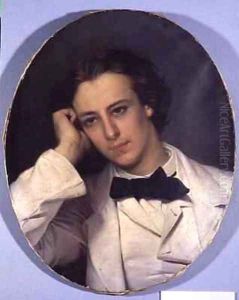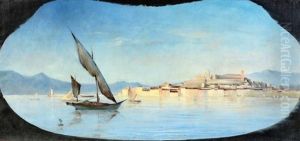Paul Dubufe Paintings
Paul Dubufe, born Édouard Louis Dubufe on March 31, 1827, in Paris, France, was a 19th-century French painter known for his portraits and historical genre scenes. He hailed from an artistic lineage, as the son of the painter Claude Marie Dubufe (1790–1864), a well-regarded portraitist of the Restoration period, and was encouraged to pursue an artistic career from an early age. Paul Dubufe's education and early career were deeply intertwined with the Parisian art world; he trained under his father and likely absorbed influences from the broader French artistic milieu of the time, including the Romantic and Neoclassical movements.
Throughout his career, Dubufe achieved considerable acclaim for his refined and elegant portraits, which often depicted members of the French aristocracy and bourgeoisie. His style, characterized by meticulous detail, soft color palettes, and a keen sensitivity to the textures of fabrics and skin, resonated with the tastes of his era. Dubufe's historical and allegorical paintings also garnered attention, though it is his portraiture that has left a more enduring legacy.
Dubufe's work was regularly exhibited at the Paris Salon, the official art exhibition of the Académie des Beaux-Arts in Paris, where he received several medals and honors over the years. His success afforded him a prestigious clientele, including French nobility and prominent figures of the day. Beyond his individual achievements, Dubufe's legacy is also tied to his contributions to the artistic community in Paris, including mentoring younger artists and participating in the cultural life of the city.
Paul Dubufe's later years were marked by continued artistic production and recognition. He passed away on August 9, 1909, in Paris. Today, his works are housed in various museums and collections around the world, where they continue to be studied and appreciated for their elegance and historical value. Dubufe's contributions to 19th-century French art, particularly in the realm of portraiture, underscore his role as a key figure in the artistic landscape of his time.

